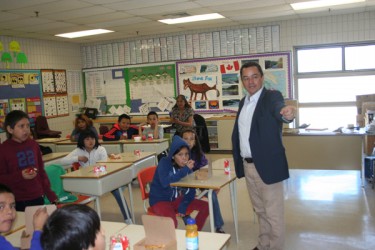Article Origin
Volume
Issue
Year
A visit from the National Chief of the Assembly of First Nations proved to students at Otter Nelson River School that they are being heard.
“It’s a form of encouragement, acknowledgement to the students that people are listening to them,” said Clarence Haney, principal of the lower elementary and high school on the Cross Lake First Nation.
High school students Lane Umpherville and Courtney McKay produced a nearly 11-minute long video about their school in response to a national video contest launched by Atleo. By deadline time at the end of February, six videos had been received and a random draw made. The Cross Lake school, along with iCount school in Moricetown, B.C. were the winners of school visits from Atleo bearing school accessories as gifts.
“The students were very excited. It was a great honour for the whole community, especially our school,” said Haney, who appreciated Atleo fitting the school into his busy schedule. “It was a great thing.”
“It is always so important to hear directly from the students about their education, their specific hopes and their needs,” said Atleo in a news release.
The contest was an opportunity for students to showcase their schools, both the good qualities and the aspects in which they are lacking. Other videos came from Truro Junior High (Millbrook, Nova Scotia), Otetiskiwin Kiskinwamahtowekamik Elementary School (Manitoba), and B.C. schools Nkamplx i Snmamayatn kl sqilxwtet and Lamle’ Iwesawtexw—Seabird Island Community School.
All schools talked about the great teachers they had and the cultural and language classes that were offered. But they also talked about the programs that were missing, the need for larger schools, and the need for better equipment, whether physical education or technology.
Otter Nelson River School also needs a new facility, said Haney. The building is 20-plus years old and overcrowded. There are more than 1,000 students, split almost evenly between the Kindergarten to Grade 4 classes and the Grades 9 to 12 classes. An extension is being used to hold four classes. Two other classes are housed in the University of the North building.
“We’re busting at the seams,” said Haney. “We’ve gone through the proper channels and everything else (to get a new school). I was led to believe that basically it’s the federal government that will dictate when we do get a new school.”
Education on First Nation reserves is funded by the federal government and the rate at which Ottawa supports the students has been strongly criticized by organizations, including the AFN, over the years. There has been a push for equality in funding with provincial counterparts.
“Education remains a clear priority for all First Nations across the country… First Nations will not rest until we have created new systems and a better approach to First Nations education,” said AFN Regional Chief Morley Googoo (Nova Scotia/Newfoundland), who holds the portfolio for education.
Otter Nelson River School is also in need of new technology and the class sizes are large.
But despite the needs, the school has had very little change in staff in the five years Haney has been at the helm.
“The school has a very positive atmosphere,” he said. “We work together, we collaborate. It’s great. We work as a unit.”
There is about 100 staff, which includes 22 teachers in the elementary and 21 teachers at high school, school counsellors, resource teachers, classroom aides, and administration. There is only one teacher at the elementary level who is not Aboriginal, while half the high school teachers are Aboriginal. Haney himself is Métis.
Atleo visited iCount School on May 15.
- 4162 views

